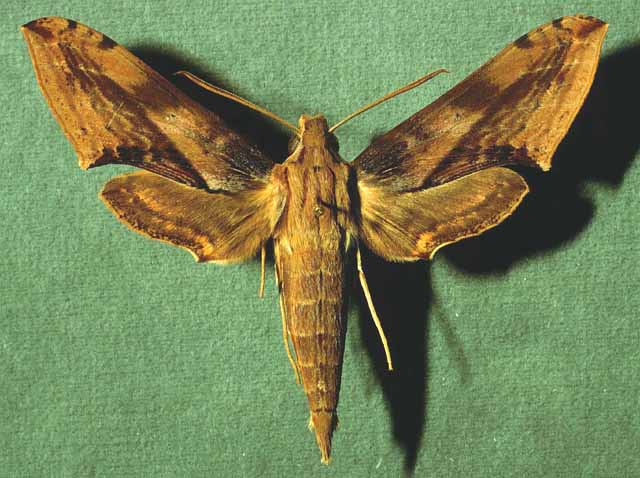Xylophanes rhodina
Rothschild & Jordan, 1903
Xylophanees rhodina male, costa Rica, courtesy of Dan Janzen.

Xylophanees rhodina male, costa Rica, courtesy of Dan Janzen.
This site has been created by
Bill Oehlke at oehlkew@islandtelecom.com
Comments, suggestions and/or additional information are welcomed by Bill.
TAXONOMY:
Family: Sphingidae, Latreille, 1802 |
MIDI MUSICcopyright C. Odenkirk ON.OFF |
Similar to Xylophanes godmani but outer margin of forewing entire and almost straight, apex less falcate, tornus less pronounced.
MaleAbdomen with a scattering of long, pinkish-grey scales and a triple dorsal line.
Forewing upperside orange-brown with darker brown markings; discal spot mall, black, with a dark brown cloud distal to it that stretches longitudinally across the
wing from the costa to the submarginal line; basalmost postmedian line straight, strong from costa to M1, where it merges with the longitudinal band; other
postmedian lines faint.
Basal half of forewing underside and marginal band uniform pale brown, between which the postmedian area is pale orange strongly suffused with red and covered in a
variable degree of dark brown spotting; pattern of longitudinal band and postmedian lines of upperside replicated below.
Median band narrow, orange, edged in dark brown with outer edging twice as broad as inner.
General coloration as forewing underside, only postmedian band conspicuous. CATE

Xylophanes rhodina male, San Jose, Costa Rica,
on my home computer only.
Moths emerge approximately one-two months after larvae pupate.
Use your browser "Back" button to return to the previous page.
Goto Main Sphingidae Index
Goto Macroglossini Tribe
Goto Central American Indices
Goto Carribean Islands
Goto South American Indices
Goto U.S.A. tables